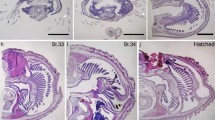Summary
Immunocharacteristics of the pars distalis cells of the pituitary of the male lizard A. carolinensis are determined by employing the immunoperoxidase technique with antisera to mammalian pituitary hormones. On the basis of their immunoreactivity, 5 different cell types with characteristic anatomical distribution are recognized. ACTH cells are found in the rostral half of the pars distalis, and PRL cells in the rostral two thirds of the pars distalis. GH and TSH cells are located in the caudal half of the pars distalis. GTH cells are distributed throughout the gland. When consecutive sections are stained with antiserum to ovine FSH or its β-subunit and to ovine LH, the same cells show immunoreactivity to all the three antisera. None of the GTH cells show positive immunoreactivity to ovine β-LH antiserum. The results suggest the existence of one gonadotropic cell type in the pituitary of this lizard.
Similar content being viewed by others
References
Dancasiu M, Cimpeanu L, Petrovici A, Penea C (1967) Ultrastructure de l'hypophyse d'Emys orbicularis male au cours du cycle annuel. Rev Roum Endocrinol 5:125–127
Del Conte E (1969) The corticotroph cells of the anterior pituitary gland of a reptile: Cnemidophorus l. lemniscatus (Sauria, Teiidae). Experientia 25:1330–1332
Del Conte E (1975) Correlated changes in the structure of the anterior pituitary gland, testes and interrenal tissue during sexual maturation of male lizards. Cell Tissue Res 157:493–502
Del Conte E (1979) Ultrastructural aspects of degradation and necrosis of Leydig cells in lizards by effect of metyrapone. Gen Comp Endocrinol 37:101–110
Della Corte F, Galgano M, Angelini E (1968) Ultrastuttura della pars distalis dell'ipofisi di Lacerta s. sicula Raf., nei maschi in activita sessualeed in quelli castrati. Z Zellforsch 90:596–615
Doerr-Schott J (1976) Immunohistochemical detection, by light and electron microscopy, of pituitary hormones in cold blooded vertebrates. II. Reptiles. Gen Comp Endocrinol 28:513–529
Forbes MS (1971) Ultrastructure of the thyrotropic cell in the pars distalis of the lizard. Gen Comp Endocrinol 16:452–464
Guedenet JC, Bugnon C, Fellmann D, Grignon G (1975) Etude immunocytochimique des cellules corticotropes de l'hypophyse de la Tortue terrestre (Testudo mauritanica). CR Acad Sci Ser D 281:1253–1256
Holmes RL, Ball JN (1974) The pituitary gland. A comparative account. Cambridge University Press, London, pp 288–322
Licht P, Pearson AK (1978) Cytophysiology of the reptilian pituitary gland. Int Rev Cytol Suppl 7:239–286
Mohanty KC, Naik DR (1979) Application of lead-hematoxylin and methyl blue staining for the identification of ACTH and ICSH cells in the adenohypophysis of the scincid lizard, Mabuya carinata (Schneider). Gen Comp Endocrinol 39:297–308
Naik DR, Dominic CJ (1972) The pituitary gland of the musk shrew Suncus murinus L. (Insectivora), with special reference to the cytology of the adenohypophysis. Am J Anat 134:145–166
Naik DR, Sar M, Stumpf WE (1980) Immunohistochemical identification of cell types in the pars distalis of the pituitary in two species of lizards. 3lst Annual Meeting Histochem Soc, New Orleans, abstr 38
Nonnette-Ferray L, Toubeau G (1977) Identification par immunofluorescence des cellules a activite corticotrope et melanotrope α dans l'hypophyse de la couleuvre a collier Natrix natrix (L). CR Acad Sci (Paris) 284:461–464
Pearson AK, Licht P, Zambrano D (1973) Ultrastructure of the pars distalis of the lizard Anolis carolinensis, with special reference to the identification of the gonadotropic cell. Z Zellforsch 137:293–312
Saint Girons H (1970) The pituitary gland. In: Gans C, Parsons TS (eds) Biology of the reptilia, Vol. 3. Academic Press, New York, pp 135–199
Sar M, Stumpf WE (1979) Simultaneous localization of steroid and peptide hormones in rat pituitary by combined thaw-mount autoradiography and immunohistochemistry: Localization of dihydrotestosterone in gonadotropes, thyrotropes and pituicytes. Cell Tissue Res 203:1–7
Sotowska-Brochocka J (1977) Seasonal changes in the structure and function of prolactin cells in the pituitary gland of Vipera berus (L.). Acta Physiol Pol 28:337–352
Sternberger LA, Hardy PH Jr, Cuculis JJ, Meyer HG (1970) The unlabelled antibody enzyme method of immunohistochemistry. Preparation and properties of soluble antigen-antibody complex (horseradish peroxidase-antihorseradish peroxidase) and its use in identification of spirochetes. J Histochem Cytochem 18:315–333
Yip DY, Lofts B (1976) Adenohypophysial cell-types in the pituitary gland of the soft-shelled turtle, Trionyx sinensis. Cell Tissue Res 170:523–573
Zehr DR (1978) Use of hydrogen peroxide-egg albumin to eliminate nonspecific staining in immunoperoxidase techniques. J Histochem Cytochem 26:415–416
Author information
Authors and Affiliations
Additional information
Supported by U.S. Council for International Exchange of Scholars (to D.R.N.) and PHS Grant NS09914
Rights and permissions
About this article
Cite this article
Naik, D.R., Sar, M. & Stumpf, W.E. Immunohistochemical identification of cells in the pars distalis of the pituitary of the lizard anolis carolinensis . Histochemistry 69, 19–26 (1980). https://doi.org/10.1007/BF00508363
Received:
Issue Date:
DOI: https://doi.org/10.1007/BF00508363




